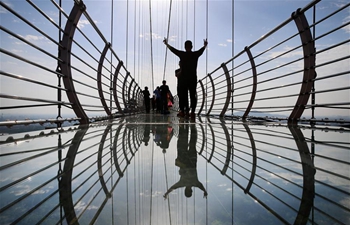WASHINGTON, May 8 (Xinhua) -- A series of events and activities will be held in the western U.S. state of Utah later this week and beyond to mark the 150th anniversary of the completion of the nation's First Transcontinental Railroad, which wouldn't have been possible without the contribution of thousands of Chinese workers.
The major event will be a three-day festival starting Friday at Promontory Summit, an area of high ground roughly 100 km northwest of Salt Lake City, where the golden spike, often referred to as the Last Spike, of the railroad was ceremonially driven in on May 10, 1869. The Golden Spike National Historical Park is located there.
It will feature speeches, historical reenactments, steam locomotive shows, and music performances, among other things, as part of a statewide celebration that also includes exhibitions and fora on the railroad, its historic significance and the contribution of early Chinese immigrants to the project, according to Spike 150, an initiative of Utah's Transcontinental Railroad 150th Celebration Commission.
"Through a series of activities and events, the Spike 150 initiative aims to inspire, educate, and reflect on the Transcontinental Railroad legacy," the initiative said on its website.
The First Transcontinental Railroad, also known as the Pacific Railroad, was a 3,000-km-plus continuous railroad line constructed between the year of 1863 and 1869 connecting the existing U.S. rail network with the Pacific coast.
The Central Pacific Railroad, a company tasked with constructing the western half of the Transcontinental Railroad, began hiring Chinese workers in 1864 after facing a labor shortage that jeopardized the railroad's completion, according to the Chinese Railroad Workers in North America Project at San Francisco-based Stanford University.
Thousands of Chinese railroad builders laid the 1,110-km track between Sacramento, California, and Promontory, Utah, contributing greatly to the completion of the transcontinental railroad, an engineering marvel that helped shape the physical and social landscape of the American West.
The builders worked under extreme conditions and in dangerous areas but were paid poorly and subject to discrimination during the construction. Details of their lives had remained largely unknown until recent years.
"Without the Chinese migrants, the Transcontinental Railroad would not have been possible," Gordon Chang, professor of American history at Stanford University and co-director of the research project, has recently told Xinhua.
The U.S. Department of Labor honored 12,000 Chinese railroad workers in 2014 by registering them in the agency's Hall of Honor.
"Their efforts, which connected the western United States to the eastern United States, laid the foundation for the extraordinary economic prosperity enjoyed by the United States in the years that followed," the agency said on its website.













